Sizing Up Servers: Intel's Skylake-SP Xeon versus AMD's EPYC 7000 - The Server CPU Battle of the Decade?
by Johan De Gelas & Ian Cutress on July 11, 2017 12:15 PM EST- Posted in
- CPUs
- AMD
- Intel
- Xeon
- Enterprise
- Skylake
- Zen
- Naples
- Skylake-SP
- EPYC
Intel’s Turbo Modes
A last minute detail from Intel yesterday was information on the Turbo modes. As expected, not all of the processors actually run at their rated/base frequency: most will apply a series of turbo modes depending on how many cores are registered as ‘active’. Each core can have its frequency adjusted independently, allowing VMs to take advantage of different workload types and not be hamstrung by occupants on other VMs in the same socket. This becomes important when AVX, AVX2 and AVX-512 are being used at the same time.
Most of the turbo modes are a sliding scale, with the peak turbo used when only one or two cores are active, sliding down to a minimum frequency that may be the ‘base’ frequency or just above it. There’s a lot of information for the parts here, so we’ll break it down into stages.
First up, a look at the Platinum 8180 in the different modes:
It should be worth noting what the base frequency actually is, and some of the nuance in Intel’s wording here. The base frequency is the guaranteed frequency of the chip – Intel sells the chip with the base frequencies as the guarantee, such that when the chip is not idle and not in normal conditions (i.e. when not in thermal power states to reduce temperature) should operate at this frequency or above it. Intel also lists the per-core turbo frequencies as ‘Maximum Core Frequencies’ indicating that the processors could be running lower than listed, depending on power distribution and requirements in other areas of the chip (such as the uncore, or memory controller). It’s a vague set of terms but ultimately the frequency is determined on the fly and can be affected by many factors, but Intel guarantees a certain amount and provides guides as to what it expects the turbo frequencies to be.
As for the Platinum 8180, it keeps its top turbo modes while up to two cores are active, and then drops down. It does this again for another two cores, and a further two cores. From this point, under non-AVX load the CPU is pretty much the same frequency until >20 cores are loaded, but does not decrease that much in all. For AVX 2.0 and AVX-512, the downward slope of more cores means less frequency continues, with AVX-512 taking a bigger jump down at 13 cores loaded. The final turbo frequency for AVX-512 running on all cores is 2.3 GHz.
Comparing the two 28-core CPUs for which we have turbo information gives this graph. The numbers relate to the number of cores need to be loaded for that frequency.
Both processors are equal to each other for dual core loading, but the separation occurs when more cores are loaded. As we move through to AVX 2.0 and AVX-512, it is clear where the separations are in performance – to get the best for variable core loading, the more expensive processors are required.
Here’s the big table for all the processors on Non-AVX loading:
Despite the 2.0/2.1 GHz base on most of the Platinum series, all the CPUs will turbo up to 3.7-3.8 GHz on low core loading except for the lower power Platinum 8153. For users wanting to strike a good balance between the core count and frequency, the Gold 6154 is probably the place to be: 18 cores that will only ever run at 3.7 GHz with non-AVX loading (3.5-2.7 GHz on AVX-512 depending on core count), and will be $3543 as a list price at 205W. It is perhaps worth noting that this will likely top any of the Core i9 processors planned: at 18-cores and 205W for 3.7 GHz, the Core i9-7980XE which will have 18 cores but run 165W will likely be clocked lower (but also only ~$2000).
Moving onto AVX2.0 and AVX-512:


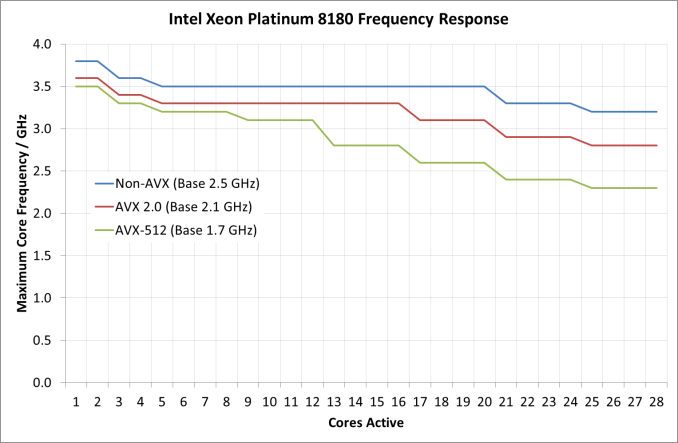
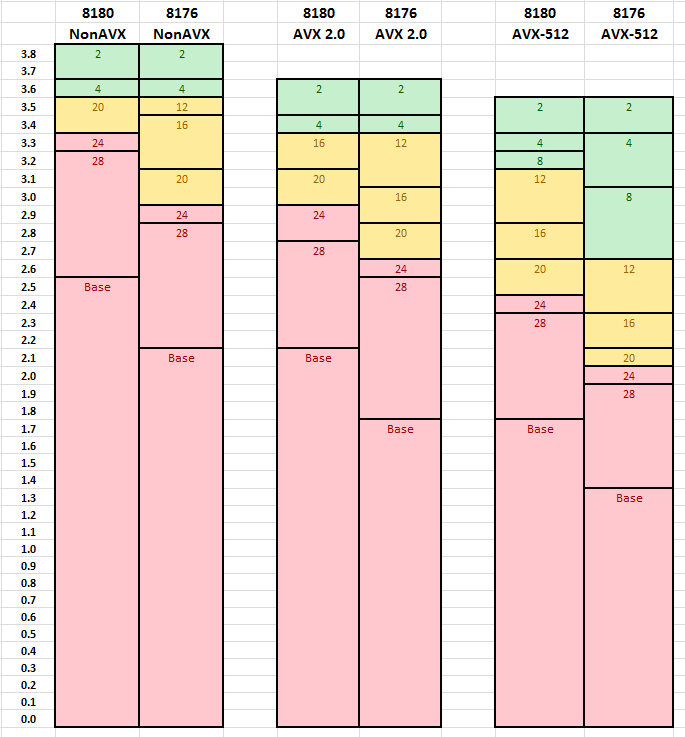
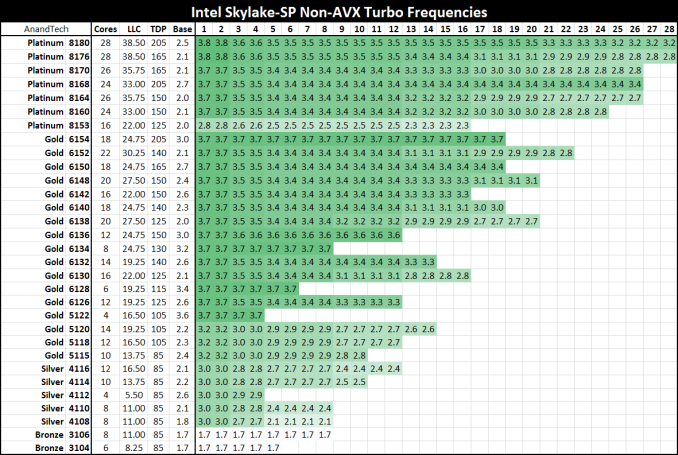
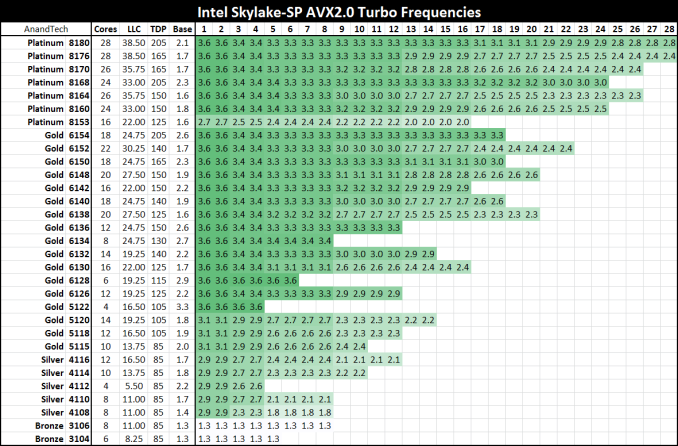
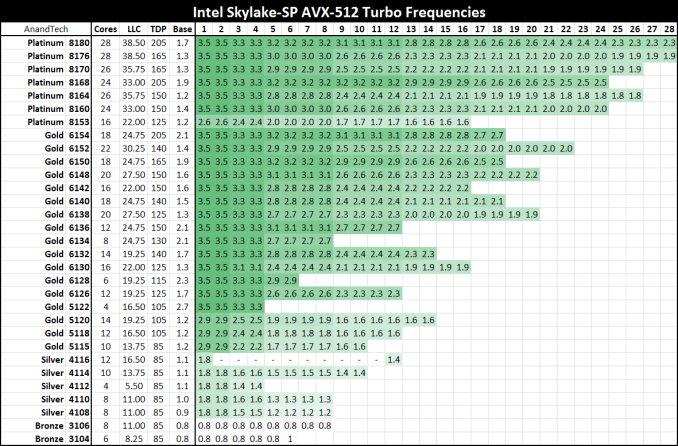








219 Comments
View All Comments
JohanAnandtech - Friday, July 21, 2017 - link
Thanks! It is was a challenge, and we will update this article later on, when better kernel support is available.serendip - Tuesday, July 11, 2017 - link
What idiot marketroid thought it was cool to have a huge list of SKUs and gimped "precious metals" branding? I'd like to see Epyc kicking Xeon butt simply because AMD has much more sensible product lists and there's not much gimping going on.ParanoidFactoid - Tuesday, July 11, 2017 - link
Reading through this, the takeaway seems thus. Epyc has latency concerns in communicating between CCX blocks, though this is true of all NUMA systems. If your application is latency sensitive, you either want a kernel that can dynamically migrate threads to keep them close to their memory channel - with an exposed API so applications can request migration. (Linux could easily do this, good luck convincing MS). OR, you take the hit. OR, you buy a monolithic die Intel solution for much more capital outlay. Further, the takeaway on Intel is, they have the better technology. But their market segmentation strategy is so confusing, and so limiting, it's near impossible to determine best cost/performance for your application. So you wind up spending more than expected anyway. AMD is much more open and clear about what they can and can't do. Intel expects to make their money by obfuscating as part of their marketing strategy. Finally, Intel can go 8 socket, so if you need that - say, high core low latency securities trading - they're the only game in town. Sun, Silicon Graphics, and IBM have all ceded that market.msroadkill612 - Wednesday, July 12, 2017 - link
"it's near impossible to determine best cost/performance for your application. So you wind up spending more than expected anyway. AMD is much more open and clear about what they can and can't do. Intel expects to make their money by obfuscating as part of their marketing strategy.Finally, Intel can go 8 socket, so if you need that - say, high core low latency securities trading - they're the only game in town. Sun, Silicon Graphics, and IBM have all ceded that market."
& given time is money, & intelwastes customers time, then intel is expensive.
Those guys will go intel anyway, but just sayin, there is already talk of a 48 core zen cpu, making 98 cores on a mere 2p mobo.
As i have posted b4, if wall street starts liking gpu compute for prompter answers, amdS monster apuS will be unanswerable.
nils_ - Wednesday, July 19, 2017 - link
98 cores on a 2p mobo isn't quite right if you keep in mind that the 32 core versions already constitute a 4 CPU system, unless AMD somehow manages to get more cores on a single die.nils_ - Wednesday, July 19, 2017 - link
Good analysis, although Sun and IBM are still coming out with new CPUs and at least with IBM there is renewed interest in the POWER ecosystem.eek2121 - Wednesday, July 12, 2017 - link
, but rather AMD's spanking new EPYC server CPU. Both CPUs are without a doubt very different: micro architecture, ISA extentions, <snip>Should be extensions.
intelemployee2012 - Wednesday, July 12, 2017 - link
After looking at the number of people who really do not fully understand the entire architecture and workloads and thinking that AMD Naples is superior because it has more cores, pci lanes etc is surprising.AMD made a 32 core server by gluing four 8core desktop dies whereas Intel has a single die balanced datacenter specific architecture which offers more perf if you make the entire Rack comparison. It's not the no of cores its the entire Rack which matters.
Intel cores are superior than AMD so a 28 core xeon is equal to ~40 cores if you compare again Ryzen core so this whole 28core vs 32core is a marketing trick. Everyone thinks Intel is expensive but if you go by performance per dollar Intel has a cheaper option at every price point to match Naples without compromising perf/dollar.
To be honest with so many Fabs, don't you think Intel is capable of gluing desktop dies to create a 32core,64core or evn 128core server (if it wants to) if thats the implementation style it needs to adopt like AMD?
The problem these days is layman looks at just numbers but that's not how you compare.
sharath.naik - Wednesday, July 12, 2017 - link
Agree, Most who look at these numbers will walk away thinking AMD is doing well with EPYC. The article points out the approach to testing and also states the performance challenges with EPYC, which can be missed who reading this review without the prior review on the older Xeons. For example the Big data test, I bet the newbies will walk away thinking EPYC beats the older XEONS E5 v4, as thats what the graphs show,without ever looking back at the numbers for a single 22 core Xeon e5 v4. So yes, a few back links in the article will be helpful.warreo - Wednesday, July 12, 2017 - link
Not a fanboi of either company, but care to elaborate more? I checked the original Xeon E5 v4 review. It shows that a single Xeon E5 v4 performs about 10% slower than a dual setup. Extrapolating that here, that means the single Xeon E5 v4 setup would be right around 4.5 jobs per day, which would make it roughly 50% slower than the dual Epyc and Xeon 8176.Sure, you could argue perf/dollar is better against a dual Epyc setup...but one could make the same argument against Intel's Skylake Xeons? I also wouldn't expect the performance to scale linearly anyway. Please let me know what I'm missing.